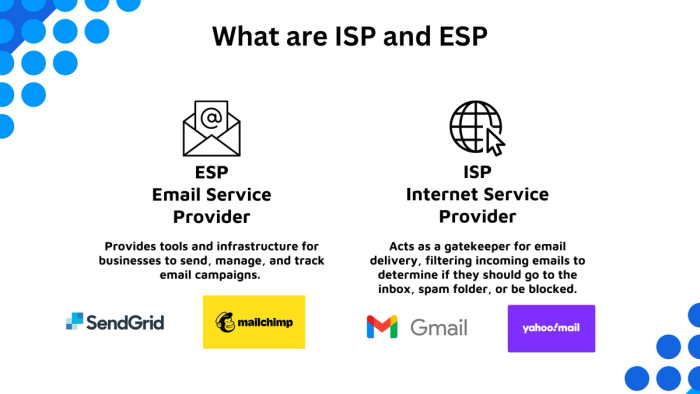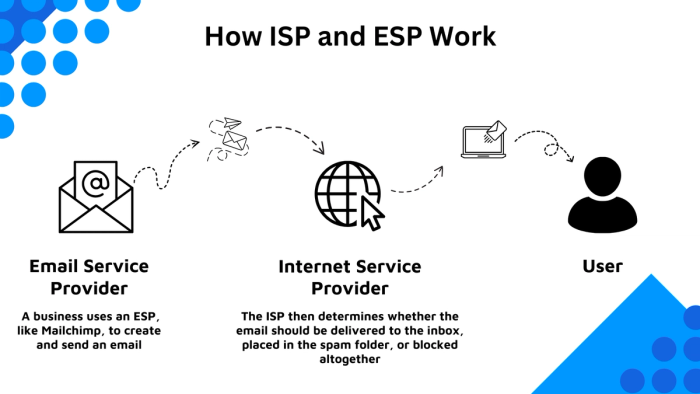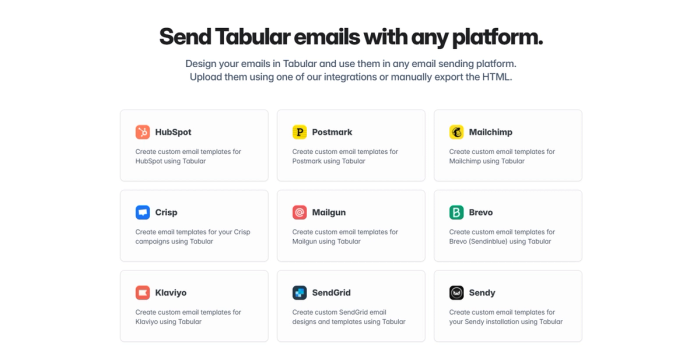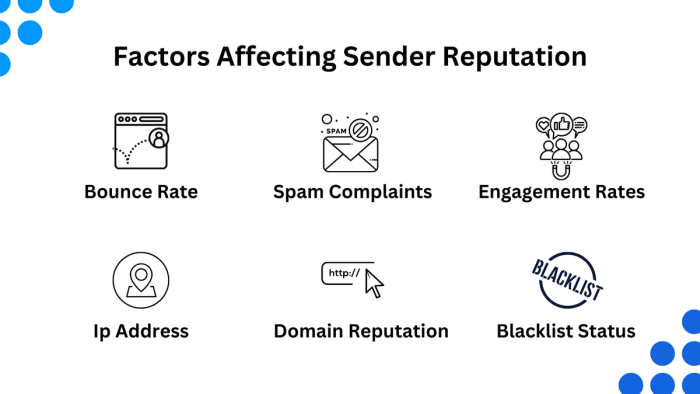What Are ISP and ESP, and How Do They Differ?
Table of contents
- How ISP and ESP Work
- What Is an Internet Service Provider (ISP)?
- How Does Your ISP Affect Email Deliverability?
- What Is an Email Service Provider (ESP)?
- 9 Factors to Consider When Choosing Your ESP
- Improving Email Deliverability with ISPs and ESPs
- Best Practices for Email Creation
- Advanced Strategies for Maximizing Deliverability
- Integrating ESPs with Other Marketing Tools
- Conclusion
We open our computers or phones, scroll through social media, check our emails, browse some memes... and we do all this quite naturally. Being so immersed in digital platforms, we often don’t stop to think about the mechanisms behind these spaces.
As William Gibson put it, cyberspace draws from multiple sources. One essential source is the internet, and another is something more personal—your email address, your unique online identity. This brings us to the focus of this article: What are ISPs and ESPs, what are their roles in email marketing, and how do they connect?

If you’re familiar with cyberspace, you’ve likely heard of Internet Service Providers (ISP) and Email Service Providers (ESP). In this article, we’ll explore what they mean, where they’re applied, and how to incorporate them into marketing. So, let’s dive into some key concepts.

How ISP and ESP Work
Let’s say a company uses Mailchimp (ESP) to send a newsletter to subscribers who use Gmail, Yahoo, and Comcast as their email providers (ISPs). Here’s how the process would look:
- Mailchimp prepares the email, applying best practices to avoid spam markers, and then sends it over the internet to the ISPs.
- Gmail, Yahoo, and Comcast (ISPs) receive the email and analyze it. They consider sender reputation, the content, and user engagement to decide if it’s safe and relevant.
- If the email meets the ISP’s criteria (e.g., no spammy keywords, reputable sender), it goes to the inbox.
- If not (e.g., low sender reputation), it might land in the spam folder or be blocked.
In summary:
- ISPs provide connectivity and serve as gatekeepers, ensuring only safe and relevant emails reach users.
- ESPs help businesses send emails effectively, managing the process to maximize deliverability through ISP filters.
What Is an Internet Service Provider (ISP)?
To start, let’s clarify what ISP stands for: Internet Service Provider. Essentially, this is the service that supplies internet connectivity to an individual’s computer or to a company. You might think of it as the gateway to accessing the internet.
To further explain ISP, we can look at examples like AT&T, Verizon, or Comcast, which provide internet to personal computers. Through their servers, you can easily reach all kinds of information, data, or resources online.
ISPs play a significant role in shaping your experience in cyberspace. Factors like speed, reliability, and the range of content you can access are all influenced by your ISP. We’ll delve deeper into these aspects in the following section.
How Does Your ISP Affect Email Deliverability?
You can access all websites on the internet through your Internet Service Provider (ISP). However, if you’re unfamiliar with the process, you might wonder what difference it makes in terms of email deliverability. So, what does ISP mean when it comes to email delivery? Here’s a breakdown:
Proofreading and Compliance: When crafting professional marketing emails, representing your brand accurately is crucial. This is why proofreading is essential, especially for high-stakes emails. Fortunately, some ISP email services assist by offering automated sentence suggestions, helping you communicate professionally and appropriately.
Security Protocols: Each ISP includes security protocols that screen for harmful files in both uploaded and downloaded content. Exposure to malware or viruses through your email can put any online profiles connected to it at risk. By reviewing your ISP’s security policies, you can select the best match for your needs.
Sender and IP Address Reputation: Building recipient trust is essential in business communication. Establishing a trusted sender and IP reputation increases the chances of your ISP delivering emails directly to inboxes rather than marking them as spam. A strong sender reputation boosts your likelihood of maintaining high deliverability.
Email Metrics: With ISP marketing services and email authorization, you can track recipient engagement with your emails. Metrics like open rates, click-through rates, and conversions help you refine future emails based on data-driven insights, improving your email strategy over time.
Spam and Phishing Filters: Email addresses can sometimes be flagged as spam sources. To prevent this, it’s helpful to monitor outbound traffic to catch unusual patterns. If your ISP notices frequent attachments or sensitive language, it may redirect your emails to spam folders. Checking your ISP’s spam policies can help maximize email marketing efficiency.
What Is an Email Service Provider (ESP)?
So far, we’ve covered the essentials of ISPs; now, let’s dive into email marketing specifics by looking at ESPs. ESP stands for Email Service Provider, which helps businesses manage and optimize their email communications. With an ESP, you can create email templates, automate your sends, and monitor email performance metrics.
For businesses that use email marketing extensively, controlling when and what is sent is crucial. An ESP enables you to send bulk emails to customers, segment your recipients for targeted campaigns, and monitor email performance.
By aligning ESP use with your business marketing plan, you can build effective email campaigns. ESP marketing essentially means using a platform to send campaigns to specific user segments or subscriber lists. Even if you’re new to email service providers, you may be familiar with platforms like Mailchimp, Constant Contact, or SendGrid, which help find email lists, design campaigns, and manage marketing emails. Additionally, you can integrate ESPs with various online tools—for example, creating a brand-specific welcome email template on Tabular and sending it at scale with an ESP.
9 Factors to Consider When Choosing Your ESP
If you're interested in ESP email marketing, here’s some great news: as a growing and widely-used marketing platform, ESPs offer numerous advantages and opportunities. For effective email marketing, it’s crucial to choose your ESP wisely, with a few essential factors in mind. Here’s a list of criteria to help you refine your options.
1. Features to Look For
Your ESP should support your email marketing goals. First, review its key features, such as analytics for email metrics, recipient segmentation, and automation capabilities.
For example, email metrics like open rates, click-through rates, or conversions help gauge your marketing success. Segmenting your audience and performing A/B testing using your ESP can show which subject lines, content, or design elements are most effective for your campaigns.
Create your template using our email template builder.
2. Mobile-Friendly Templates
Email marketing allows you to reach potential customers on any device. Ensure your ESP offers responsive templates that adapt to various screens—whether viewed on phones, PCs, or tablets. Responsive design improves readability and user experience across devices. For instance, Tabular’s templates let you preview designs in both desktop and mobile formats to ensure the best viewing experience.
A good email template is crucial if you want to keep your emails out of spam folders. Unoptimized HTML, hosting images, and other factors are important to consider when building an email template. But if you’re using Tabular, the only thing you need to worry about is reflecting your brand in the best way. Tabular integrates easily with all major ESPs, allowing you to get the most out of your email marketing campaigns. Check out our Mailchimp templates and try one for yourself—it’s free!

3. Pricing Plans
Budgeting is essential. Compare ESP pricing plans alongside features, and review both monthly and annual rates to evaluate cost-effectiveness in line with your budget.
4. Scalability Matters
As your business grows you’ll want an ESP that can expand with you rather than needing frequent upgrades or replacements. When comparing providers, consider scalability so that you can seamlessly adjust campaigns and keep up with your evolving business needs.
5. Quality of Support Team
Issues can arise unexpectedly, and fast, reliable support is invaluable in resolving them. Look for ESP providers with responsive customer support and positive reviews. Strong support can assist with any deliverability or functionality problems, keeping your email marketing efforts on track.
6. Deliverability Rates
A well-crafted email that ends up in a spam folder can undermine your efforts. High deliverability rates indicate that an ESP is trusted by ISPs, ensuring your emails are more likely to reach customers’ inboxes. Check ESPs' deliverability performance and spam-checking tools to ensure your campaigns reach your audience.
7. User-Friendly Interface
Ease of use is crucial in any online tool. Evaluate ESPs for an intuitive, device-friendly interface that simplifies campaign creation and management, helping you efficiently design quality email marketing templates.
8. Security and Compliance
Security in ESP marketing should be a top priority. Since sensitive business data and customer information are involved, ensure your ESP complies with regulations like GDPR and offers security features like two-factor authentication.
9. Integration Ease
Finally, check if your ESP integrates well with other tools, such as CRMs and marketing platforms, to streamline campaign updates. An ESP with seamless integration capabilities helps you maintain an efficient, cohesive email marketing strategy across platforms.
How Does Your ESP Affect Email Deliverability?
We’ve explored the multifaceted aspects of ESP marketing, but to emphasize the importance of selecting the right ESP service, let’s delve into how your ESP impacts email deliverability.

Your ESP plays a crucial role in maintaining your sender reputation, which determines how reliably your emails reach recipients' inboxes. If your emails are flagged as untrustworthy, they’re likely to land in the spam folder, making them virtually invisible. Choosing an effective ESP service is essential to optimize deliverability rates and improve key email metrics.
Improving Email Deliverability with ISPs and ESPs
Understanding ISP Email Filters
ISP filters can be customized with preferences like blocking certain keywords or incorporating external blocklists. If your emails are flagged repeatedly, your IP address might even get blacklisted, so maintaining a clean, professional email template is crucial.
By comparing sender reputation rates among ISPs, you can identify the most effective one for your business, helping boost user engagement and enhance email deliverability.
Best Practices for Email Creation
- Avoid Spam Triggers: Steering clear of certain keywords can help keep your emails off blocklists. For instance, excessive use of capital letters often flags an email as spam without further content analysis. Overly “salesy” language may also make your message seem like automated marketing. Craft your emails carefully to avoid these triggers.
- Proper Formatting: Effective email design balances both content and aesthetics. Consider the structure of your text, banners, and closing elements when creating templates. A thoughtfully designed email is less likely to be marked as spam.
- Personalization: As discussed with segmentation, personalizing your emails can create a sense of familiarity. Addressing recipients by name or referencing past purchases or interests can make your message more engaging.
- Consistent Sending Patterns: Irregular sending patterns may increase your chances of being marked as spam. Establish a consistent schedule for newsletters, abandoned cart reminders, or special offers to build a reliable sending reputation.
Advanced Strategies for Maximizing Deliverability
Leveraging ESP Analytics for Improved Reach
Leveraging email metrics can greatly enhance your email marketing campaigns. By tracking ESP marketing analytics, you gain insights into your target audience’s behavior and can tailor your approach accordingly. For example, if your audience is primarily interested in special offers, you might focus your campaigns around holidays or special events.
Refining your campaigns and strategies allows you to connect with the most responsive audience. Additionally, by using segmentation based on various criteria, you can efficiently send targeted campaigns in bulk.
Building a Positive Sender Reputation
- Provide Consistent Value: Your brand identity is crucial for defining and representing your business. To maintain this identity, it’s important not to vary it with every email. By designing a consistent template, you ensure that your visual content remains uniform. Additionally, using similar wording in the email body helps establish a reliable and recognizable sender reputation.
- Maintain List Hygiene: A lack of engagement from subscribers may indicate that they have abandoned their email addresses. This can lead to lower metrics and increase the risk of being flagged as spam. Regularly cleaning up your list by removing inactive subscribers is essential for maintaining healthy engagement rates.
- Follow Email Best Practices: Building a long-lasting relationship with your audience is rooted in trust and respect. Rather than forcing recipients to receive your emails, offer them options for subscribing or unsubscribing. You can also entice subscribers by providing special offers for those who join your email newsletter, making them feel valued.
Integrating ESPs with Other Marketing Tools
Online tools simplify the integration of various marketing resources, allowing users to update their tech stack seamlessly.
- CRM Integration: Customer Relationship Management (CRM) is a strategic approach for businesses to organize and maintain customer contact information. By systematically managing this data, companies can effectively synchronize their marketing tools, including email metrics and analytics.
- Social Media Integration: Social media platforms enable you to engage with a more targeted audience using compelling content. By integrating your email marketing campaigns with social media, you can promote special offers, product updates, or educational content across both channels, enhancing your cross-channel marketing efforts.
Conclusion
Understanding what ESP stands for and what ISP means can significantly enhance your business growth and help you connect with the right audience. By effectively utilizing these tools, you can ensure mobile compatibility, analyze email metrics, and verify deliverability rates.
Integrating internet and email service providers into your operations can improve your sender reputation, leading to higher deliverability rates. This will ultimately reduce the chances of being flagged as spam.
We hope this explanation clarifies what ISP means and guides you in selecting the right ESP email providers for your business. Happy emailing!